Age with POWER
Dr. Wright’s secret revealed on page 18 “Don’t Drive!”
Robin’s shocking diagnosis revealed on page 14
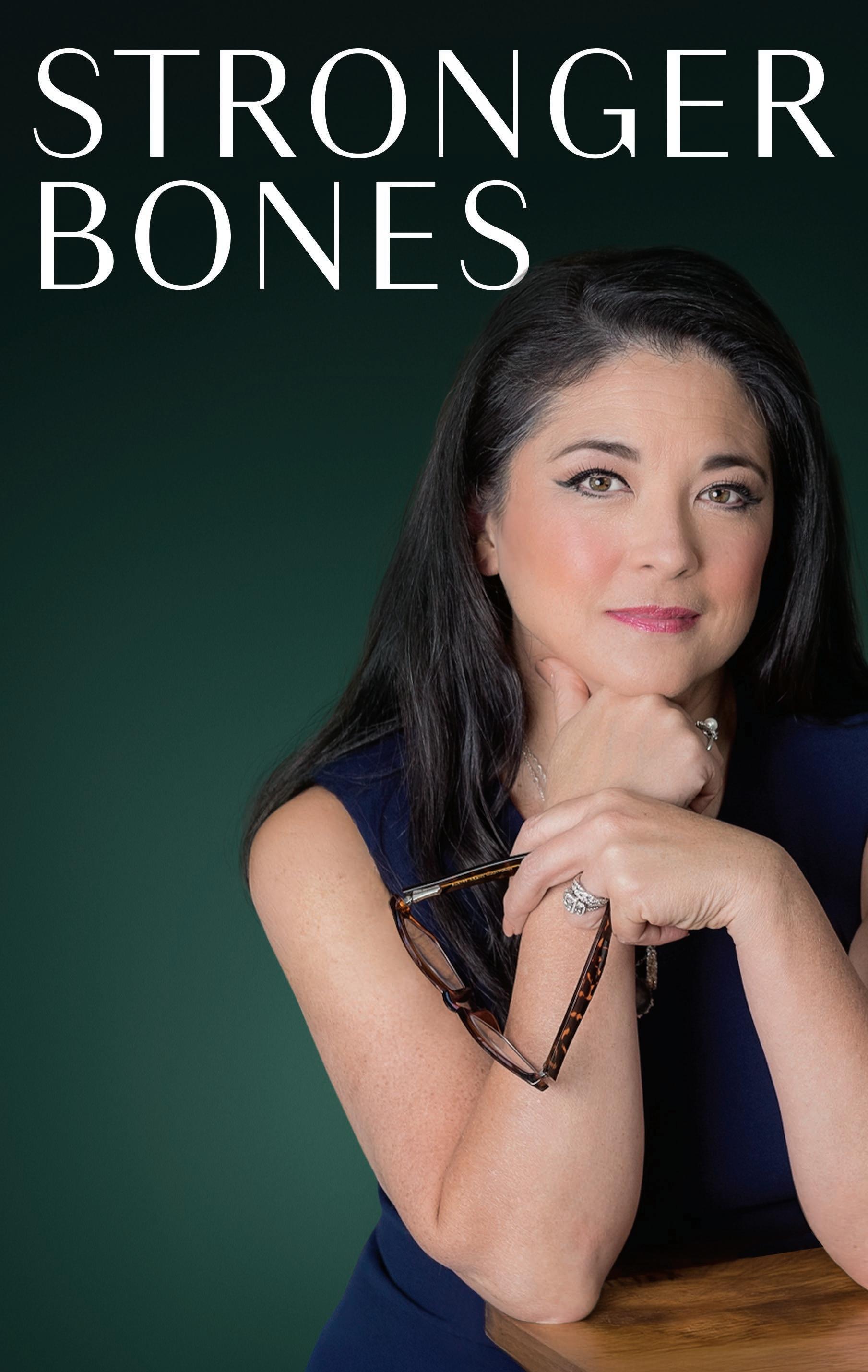
for Strong Bones? See How on page 9

Age with POWER
Dr. Wright’s secret revealed on page 18 “Don’t Drive!”
Robin’s shocking diagnosis revealed on page 14

for Strong Bones? See How on page 9
If you’re anything like me, you don’t take AlgaeCal for your bones. You take it because life is amazing and you want to keep living it as fully as possible. That’s why I’ve always said we’re not in the bone business; we’re in the life business—your life!
We want you to feel good about yourself when you can finally say ‘yes’ to a hiking invite from friends. We want you to feel good about yourself after spending an invigorating day in the garden. And we want you to feel good about yourself when you wake up in the morning—rested, calm, and ready for the day ahead. Because after all, it’s good to feel good.
That’s why I’m particularly excited about the latest addition to the AlgaeCal product line: AlgaeCal Magnesium Relax™ . It’s specifically formulated to help you feel calmer, sleep better, and stress less. And like everything we do at AlgaeCal—it’s backed by real science. The key ingredients have been put to the test in peer-reviewed human studies. And the results were nothing short of spectacular. In fact, study participants saw a 62% drop in stress symptoms in just two months.‡*
So please keep an eye on your inbox for more details about the launch of our very own AlgaeCal magnesium supplement. And remember, we’re always here for you, just a call away at 1-855-519-8540 (USA/Canada). Because in the end, it’s your success, your joy, and your life that matter most to us.
Thanks for letting us take care of you,
Dean Neuls | CEO & Co-Founder AlgaeCal Inc.
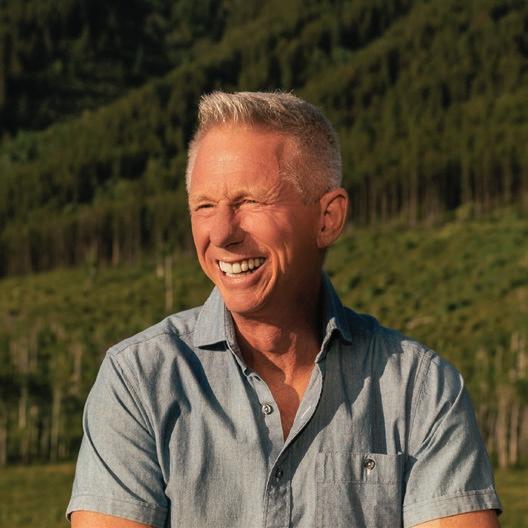
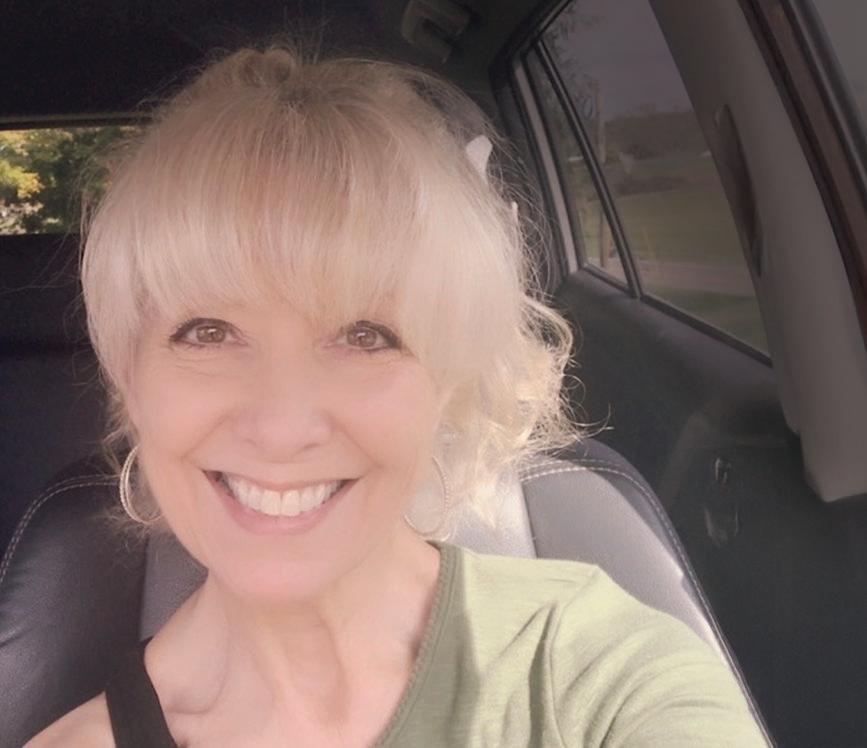

Simply
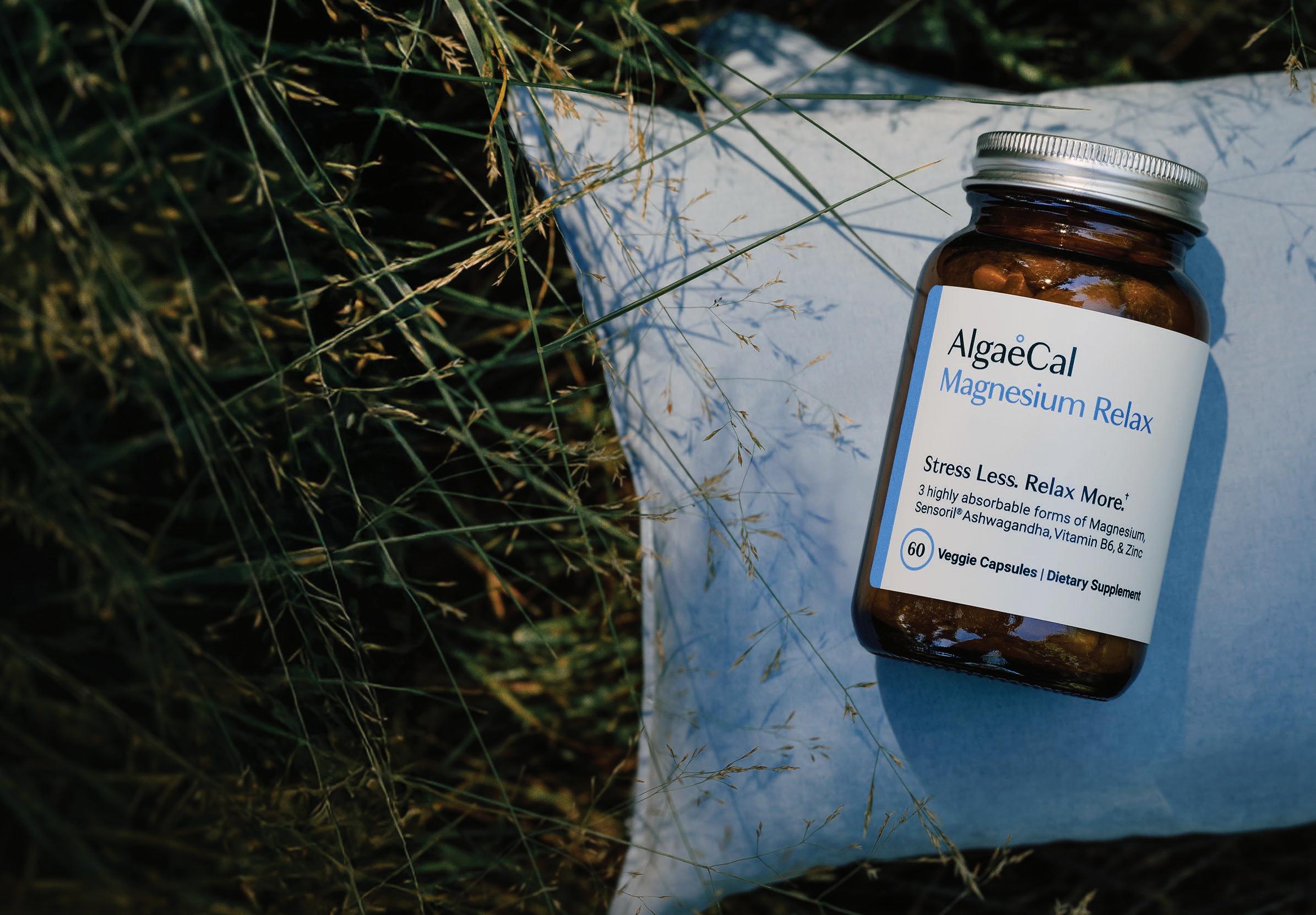
Your bones might be strong as ever, but if you’re staring at the ceiling at 3 a.m., and dragging through the day… what’s the point? That question hit us hard. So we decided to do something about it.

Dean Neuls CEO & Co-Founder AlgaeCal Inc.
When we asked our dear customers whether they were taking magnesium in addition to AlgaeCal, the answer was a resounding “yes.”
That didn’t surprise us. After all, magnesium plays a crucial role in supporting strong, healthy bones—and our community knows their stuff. But what did surprise us... was why you were taking it.
Sure, you loved how magnesium helps with calcium absorption and bone density. But many of you told us something else. That you were taking magnesium to
help with stress, sleep, and that constant sense of being “on.”
We heard the same story again and again. You weren’t just tired, you were wired and tired. You weren’t just stressed, you were stretched to the breaking point. And no matter what you tried, nothing seemed to quiet your mind or give your body the rest it craved.
That caught our attention. Because it doesn’t matter how strong your bones are—if you’re waking up feeling like you’ve been hit by a truck, dragging through the day, and lying awake at night with a racing mind, then your enjoyment of life takes a nosedive. And we don’t want that for you.
So I asked our team a simple question: Can we do something to help?
They got to work—and what they created is nothing short of extraordinary. It’s called AlgaeCal Magnesium Relax™, and it’s built for exactly what you told us you needed: a natural way to feel calm, sleep better, and let your nervous system finally exhale.
As always, we started with science. We looked for ingredients that were:
• Clinically supported in human studies
• Non-habit forming
• Gentle but effective
• And compatible with the rest of your AlgaeCal routine
And what we landed on was a formula built on 16 peer-reviewed clinical studies. All showing real results in people dealing with the same struggles you told us about: sleepless nights, bone-deep exhaustion, and nonstop stress.
Here’s what’s inside AlgaeCal Magnesium Relax™:
• Three forms of highly absorbable magnesium (including chelated bisglycinate) to help calm the body and support deep, restorative sleep.
• Sensoril® Ashwagandha, a patented adaptogen clinically supported to reduce stress.
• P5P (activated vitamin B6) and zinc chelate, which support the nervous system and hormone balance.
• And our new AlgaeCal Absorb, ™ a proprietary blend to enhance the nutrient uptake in your gut.
So what happened when real people put these ingredients to the test? Here’s what they experienced...
Measured using the same clinical tools relied on by psychologists, physicians, and researchers in peer-reviewed occasional anxiety studies worldwide.‡*
dropped by 24.2%2
That’s the stress hormone that keeps you feeling on edge all the time. It’s the same hormone responsible for those 3:00 am wakeups! When it drops, the tension fades, your body relaxes, you sleep better, and you finally feel like yourself again.‡*
CONTINUED ON PAGE 6
CONTINUED FROM PAGE 5
That’s over 4 extra hours of rest every week. No more tossing, turning, or staring at the ceiling. Just deep, steady sleep that actually leaves you feeling human again.‡*
Study participants spent more time in the deep, restorative stages of sleep—boosting sleep efficiency by 7.8%. That means they woke up feeling like they actually slept.‡*
Reduced middle-of-thenight wakeups by over 6 minutes5
So they fell back asleep before the tossing, turning, and overthinking took over.‡*
CRP (C-reactive protein) is your body’s inflammation alarm system. When you’re stressed—physically or emotionally—it shoots up and keeps your system on edge. But when it drops? Your body finally chills out. It stops bracing for the worst and starts settling down, like, “Okay...I can relax now.”‡*
7
Participants in clinical studies increased DHEAS by 32.2%—that’s the hormone
linked to resilience. When it goes up, your body handles stress better. You don’t shut down when life gets hard. You stay calm, think clearly, and keep moving forward.‡*
And perhaps the most impressive result of all?
Not a single adverse side effect was reported in any of the clinical studies.
That’s why we LOVED these ingredients. Imagine this. You crawl into bed at night and—instead of dreading another marathon of tossing and turning—your body actually lets go. You feel your shoulders soften. Your breath slows. Within minutes, you’re out.
And when morning comes? No more dragging yourself to the coffee pot like a zombie. You wake up before the alarm, stretch, and realize—you feel rested. Like your body finally hit the reset button.
During the day, the difference is just as real. The traffic jam that would have sent you into a spiral last month? You shrug it off. The never-ending to-do list? Manageable. Even the little things—like remembering where you put your keys, or having the energy to take an evening walk, suddenly feel easier.
That’s what happens when your nervous system isn’t on high alert 24/7. When your stress hormones drop. When your sleep is deep, steady, and restorative. Life doesn’t just look brighter, you feel brighter. Clearer. Calmer. Stronger.
Because let’s face it: bone health matters (it’s why you’re here). But what good are strong bones if you’re living every day on empty? When you combine AlgaeCal
with Magnesium Relax™, you’re not just building bone density. You’re reclaiming your energy, your focus, your joy.
And that’s why we created this formula. Not just so you can sleep. Not just so you can relax. But so you can finally feel like yourself again.
This isn’t just another magnesium supplement. AlgaeCal Magnesium Relax™ is a carefully formulated support system for calm, stress, and sleep. And we made it because we believe life is for living—not dragging, dreading, or pushing through.
So if you’ve been feeling stretched thin, burned out, or just not quite yourself... you’re not alone. And you don’t have to stay stuck there. There’s a way to feel calm again.
Sources
1. Auddy, Biswajit & Hazra, Jayram & Mitra, Achintya & Abedon, Bruce & Ghosal, Shibnath. (2008). A Standardized Withania Somnifera Extract Significantly Reduces Stress-Related Parameters in Chronically Stressed Humans: A Double-Blind, Randomized, Placebo-Controlled Study. Journal of American Nutraceutical Association. 11. 50-56.
2. ibid
3. Abbasi B, Kimiagar M, Sadeghniiat K, Shirazi MM, Hedayati M, Rashidkhani B. The effect of magnesium supplementation on primary insomnia in elderly: A double-blind placebocontrolled clinical trial. J Res Med Sci. 2012 Dec;17(12):1161-9.
4. ibid
5. ibid
6. Auddy, Biswajit & Hazra, Jayram & Mitra, Achintya & Abedon, Bruce & Ghosal, Shibnath. (2008). A Standardized Withania Somnifera Extract
Significantly Reduces Stress-Related Parameters in Chronically Stressed Humans: A Double-Blind, Randomized, Placebo-Controlled Study. Journal of American Nutraceutical Association. 11. 50-56.
7. ibid
*These statements have not been evaluated by the FDA and are not intended to diagnose, treat, cure, or prevent any disease or health condition.‡Results consistent with Clinical Trials, results may vary.
Visit algaecal.info/magnesium-relax or scan the QR code to learn more.
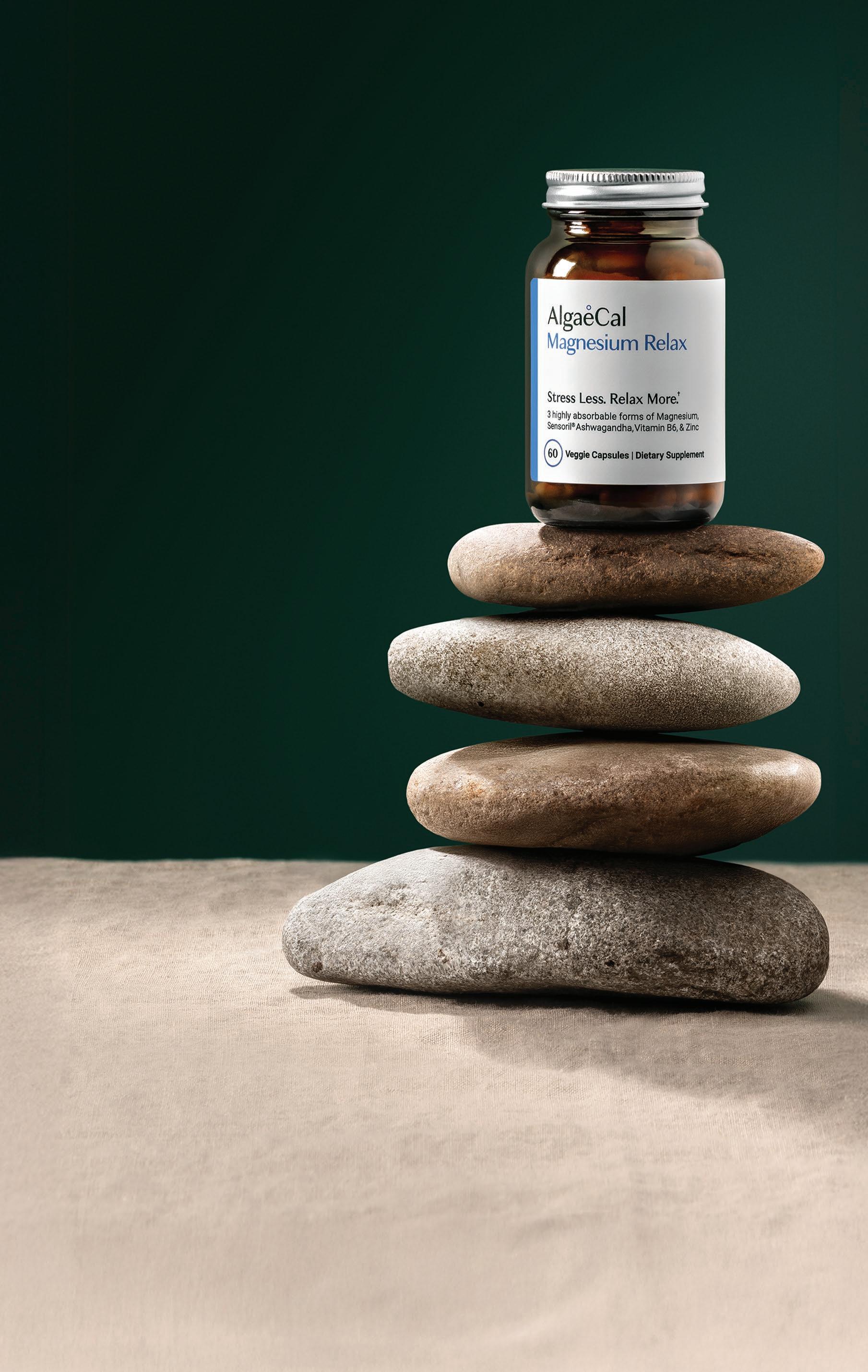
‡
Feel 62% less stressed in just 60 days‡*
Lower cortisol by 24.2%‡*
Fewer wakeups during the night‡*
Eases occasional anxiety‡*
Calms that “wired but tired” feeling‡*
Sleep deeper and longer‡*
Improves stress resilience by 32.2%‡*
Scan or visit algaecal.info/magnesium-relax to see how AlgaeCal Magnesium Relax™ can help you stress less, sleep deeper, and feel more like yourself again, naturally.
Wobbly on your feet? Just a few minutes a day could mean fewer falls and a lot more confidence.
(figure 1)
Stand with your feet about hip-width apart, with your arms by your sides, palms facing forward, wrists neutral. Stack your knees over your ankles, hips over knees, shoulders over hips, ears over shoulders—all aligned in one plane. Close your eyes and bring your awareness to the sensations in your body. Take a few breaths, noticing your ribcage expand as you inhale and draw in as you exhale.
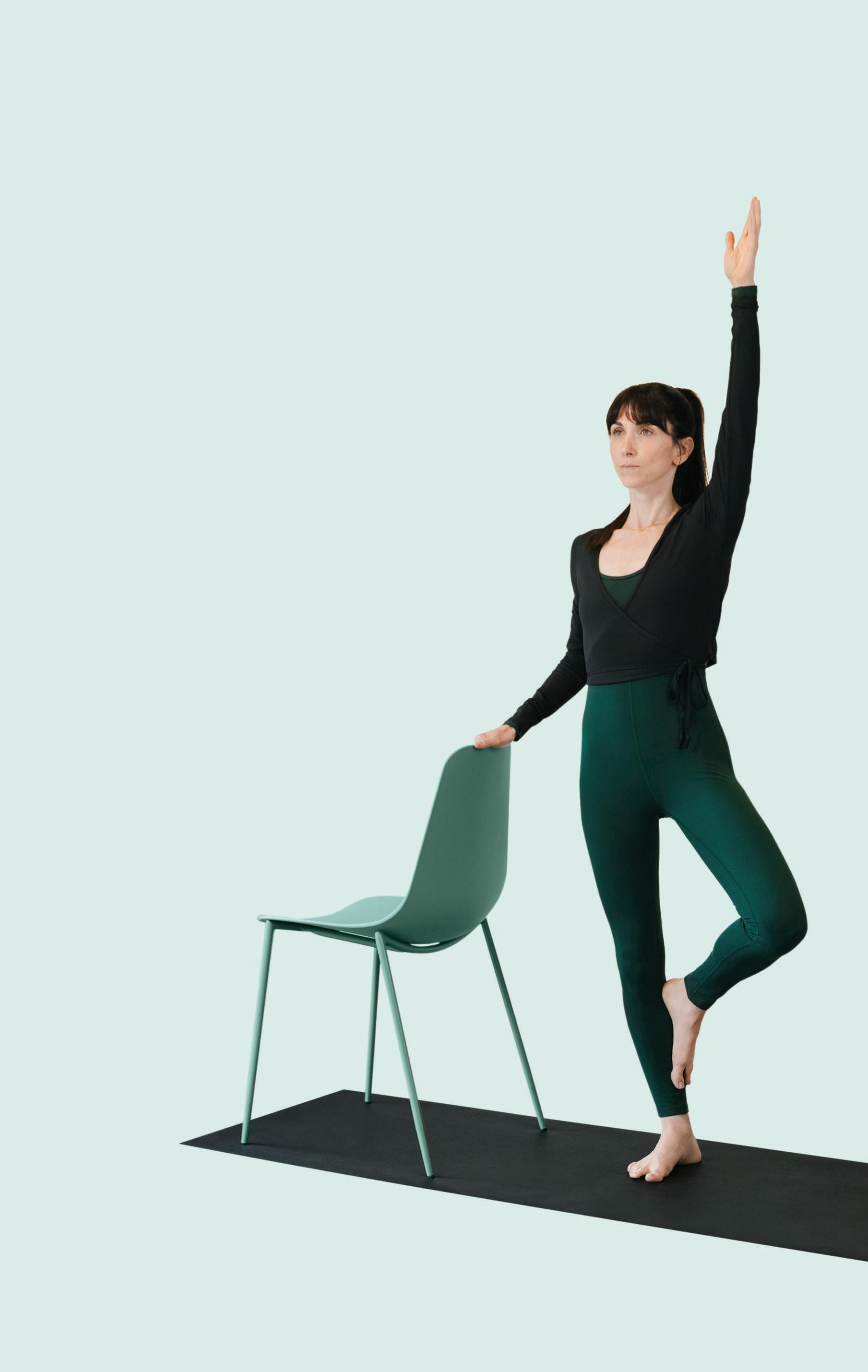
(figure 1)
(figure 2)
Stand with your back to the wall—heels slightly forward, head, upper back, and sacrum touching. Step away slightly and bend your knees so they stack over your ankles. Hinge forward with a neutral spine as you lift your arms alongside your ears. Engage your core and take a few deep breaths into your ribs. Move your hands back to the wall for stability as you come back to standing.

(figure 3)
(figure 3)
Rest your hands on the back of a chair and shift your weight onto your right foot. Keeping a slight bend in your right knee, lift your left heel back and up. Draw your navel towards your spine to activate your core and support your balance. Hold for a few breaths, then lower your foot down and repeat on the other side.
(figure 4)
Rest your hand on the back of a chair and shift your weight into your right foot. Place the sole of your left foot on your ankle, calf, or anywhere along the inside of your leg—just avoid pressing directly on your knee. Rest your gaze on a steady point in front of you and breathe. Press your standing foot down firmly to prevent your hips from swaying to one side. Bring your left foot down and repeat on the other side.
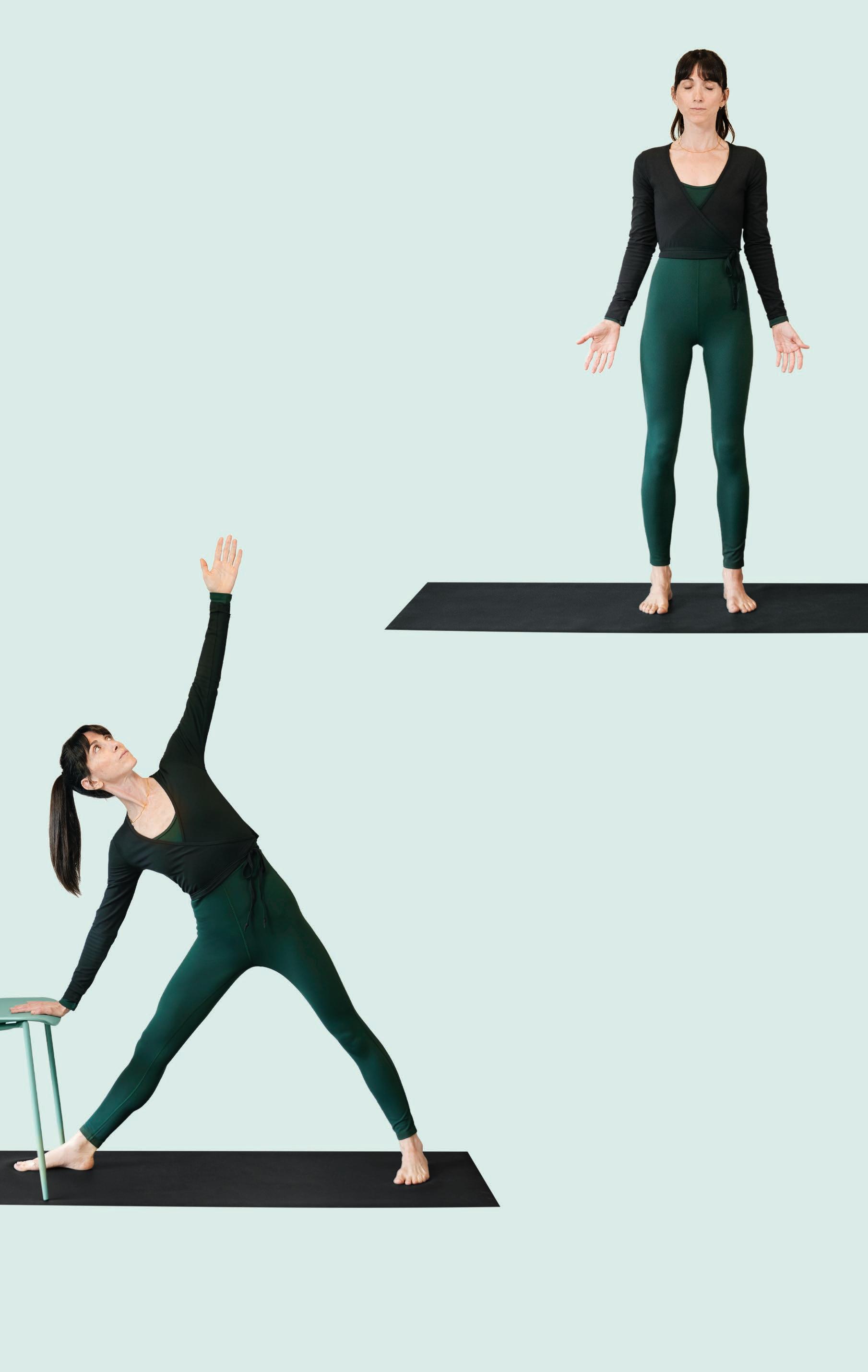
(figure 5)
5
(figure 5)
Place a chair on the right side of your mat, seat facing inward. Step your feet wide apart. Turn your right foot to face the chair and position it below the seat. Turn your left foot in slightly. Bring your arm up parallel to the floor, palms facing down. Engage your legs and ground down evenly through both feet. Reach your right hand forward, hinging at your hip, and place your hand on the seat of the chair. Draw your navel in and up to activate your core as you lift your left arm straight up. Hold for a few full breaths. Repeat on the other side.
(figure 6)
Place the back of a chair in front of you. Turn to face the short edge of your mat and rest your hand on a chair for support. Step your left foot back, coming onto the ball of your foot. Bend your right knee, keeping it in line with your right ankle. Slowly lower your left knee towards the floor. Lower and lift a few times as you maintain steady, full breaths. Repeat on the other side.
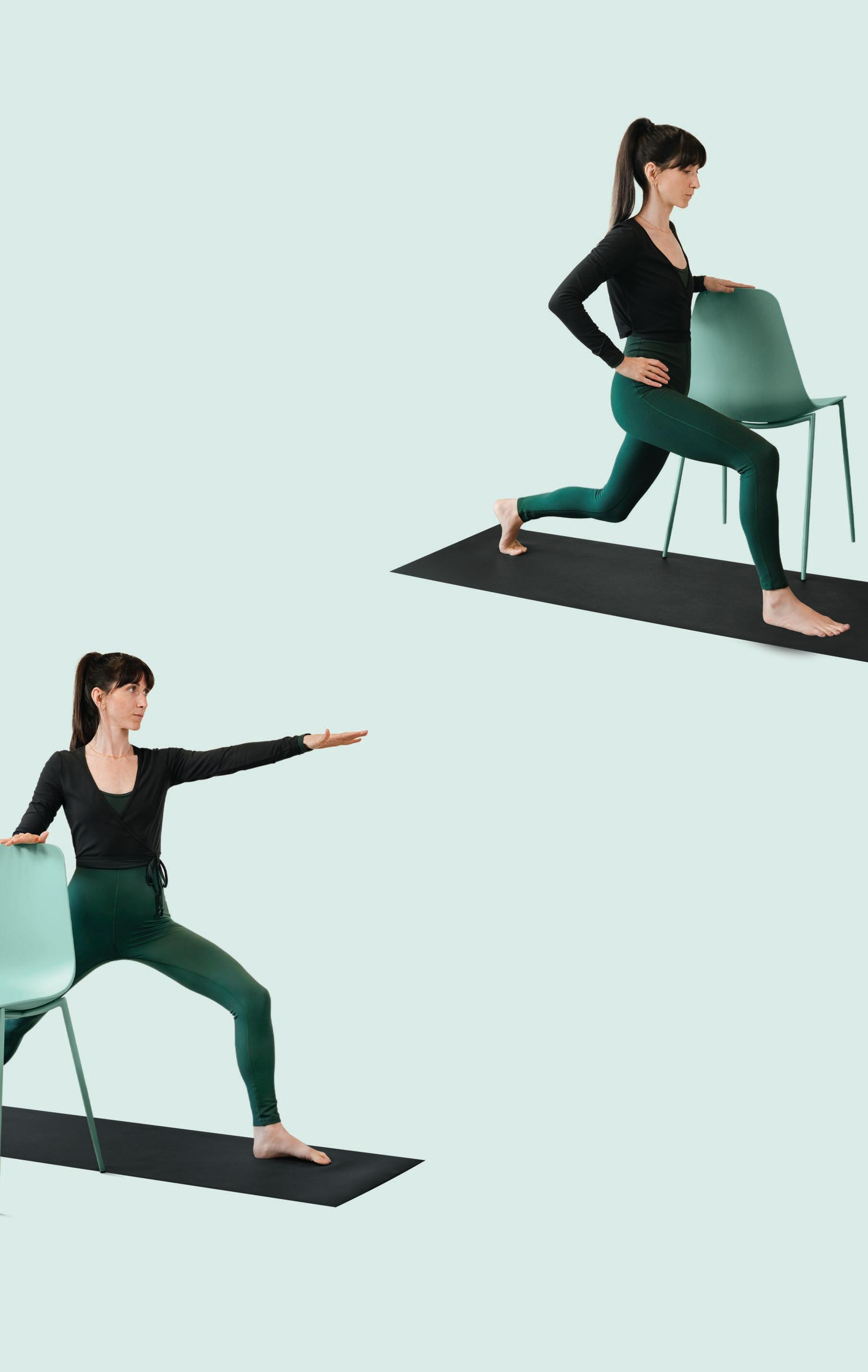
(figure 6)
7
(figure 7)
Place the back of a chair in front of you and step your feet wide apart. Turn your right toes to face the short side of the mat. Turn your left toes in slightly. Place your left hand on the back of the chair for support. Turn your torso and your gaze to face the same direction as your right foot. Bend into your right knee, keeping your knee in line with your ankle. Extend your right arm up in the same direction as your gaze. Hold for a few full breaths. Repeat on the other side.
(figure 7)
(figure 8)
Come to a comfortable, upright seated position. Let your hands rest in your lap and close your eyes. Notice any tension you might be holding in your forehead, your jaw, your shoulders—allow yourself to let go. Let your arms and legs feel heavy and allow yourself a few moments of quiet stillness.
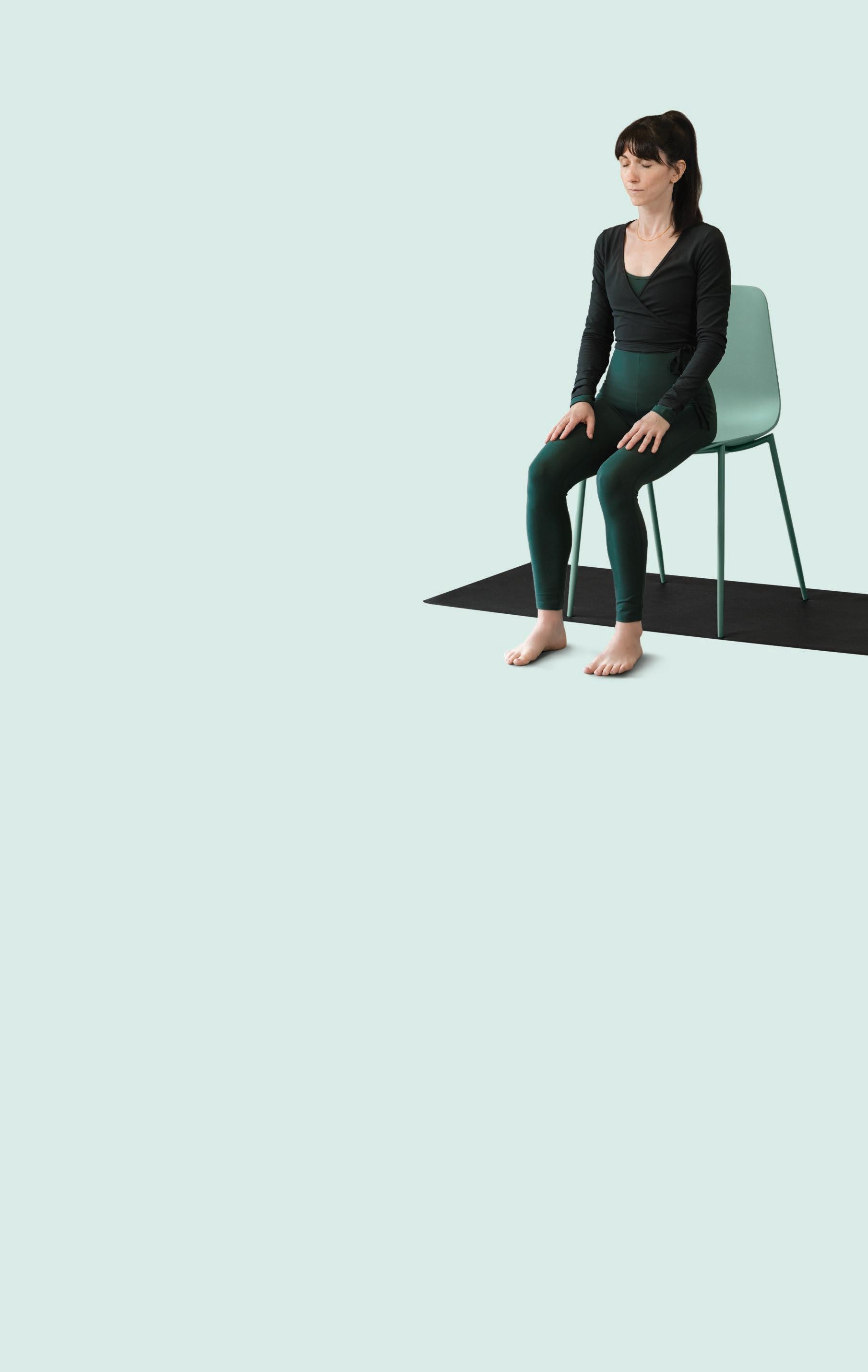
(figure 8)
Cat Buckley, BS, PGDip, is a certified yoga instructor specializing in osteoporosis. She leads movement classes for The AlgaeCal Community, helping people regain strength, balance, and body awareness—without the pressure of a typical fitness routine. Her approach is steady, practical, and rooted in science—designed to build confidence from the ground up, one pose at a time.
Scan here or visit algaecal.info/yoga-for-osteoporosis to access more gentle, bone-safe yoga poses designed to improve balance, build strength, and support your bones—all from the comfort of home.
Doctor’s warning chilled her to the bone.
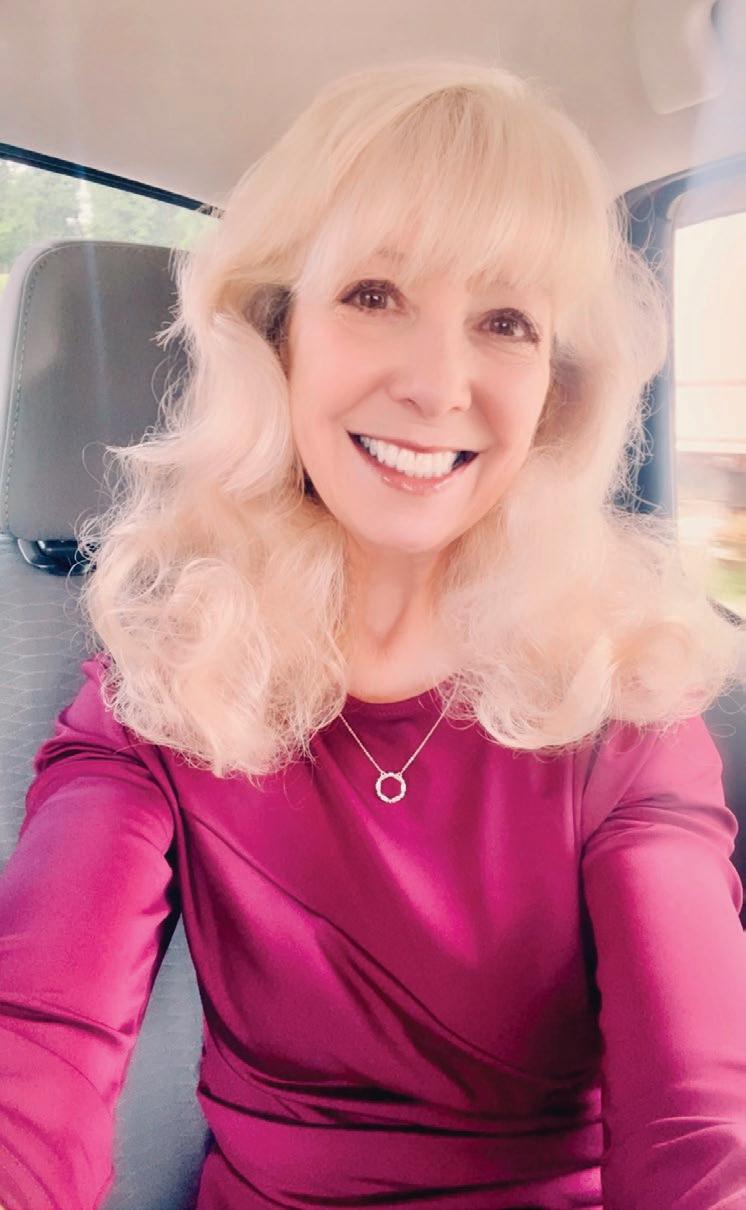
Name: Robin Lough Everitt
Location: Jane Lew, West Virginia
Testimonial Date: Feb 17th, 2025
Robin did everything right. She exercised. Ate well. Took her multivitamin. Loaded up on cottage cheese and yogurt. Her bones should have been strong. But her DEXA scans told a different story.
With every passing year, the numbers dropped. And in 2022, her doctor gave it to her straight:
“With bones as bad as yours, you could break one just by getting into a car.”
But Robin remained hopeful. She wasn’t ready to give up the active life she loved. Not without a fight. Still, she knew this wasn’t something she could ignore. “I had actually broken a wrist when I fell on the trail,” she said. “So I knew it was serious.”
So she did what many of us do when we’re scared. She opened her laptop and started searching for answers. “I had done a Google search because I like to Google,” she laughs.
“And
saw that AlgaeCal was having great results. It was a natural supplement—and
I love that.”
At first, she just tried AlgaeCal Plus. But like so many of us, she only took it when she remembered.
A capsule here, a missed day there. Nothing consistent. Nothing serious. Not yet...
But her next DEXA scan made things painfully clear. Her bones were now dangerously frail.
“The doctor said, ‘Please let me send you to the specialist,’” Robin recalls.
But that didn’t sit right with her. She wasn’t ready to hand off her future without giving it everything she had. “I said, ‘Give me one more chance to get it right.’”
That’s when everything changed. Robin ordered the Bone Builder Pack. And this time she committed. Fully.
“I started taking it religiously,” she says. “Two in the morning. Two in the afternoon. And two Strontium Boost at night.” She didn’t miss a dose.
“Sometimes I’d miss a workout. Or my yogurt. Or my multivitamin. But I didn’t miss my AlgaeCal supplements.” Then came the moment of truth.
“When
I went back for my DEXA in December, it was a 39% improvement just in my spine.”**
Her doctor was stunned. “She sent me a message right away and said, ‘Whatever you’re doing—please don’t stop.’”

CONTINUED ON PAGE 16
CONTINUED FROM PAGE 15
And she won’t. But even more important than the numbers? Robin got her confidence back.
“I’m more active now because I’m not scared. I was afraid of breaking a bone just getting into a car.”
That fear used to follow her everywhere, in the gym, on the trail, even walking upstairs. But now? It’s gone. She’s working out again. Feeling strong. Moving through life without hesitation.
And as she reflects on the journey, a smile spreads across her face. “I’m not going to stop taking this.”
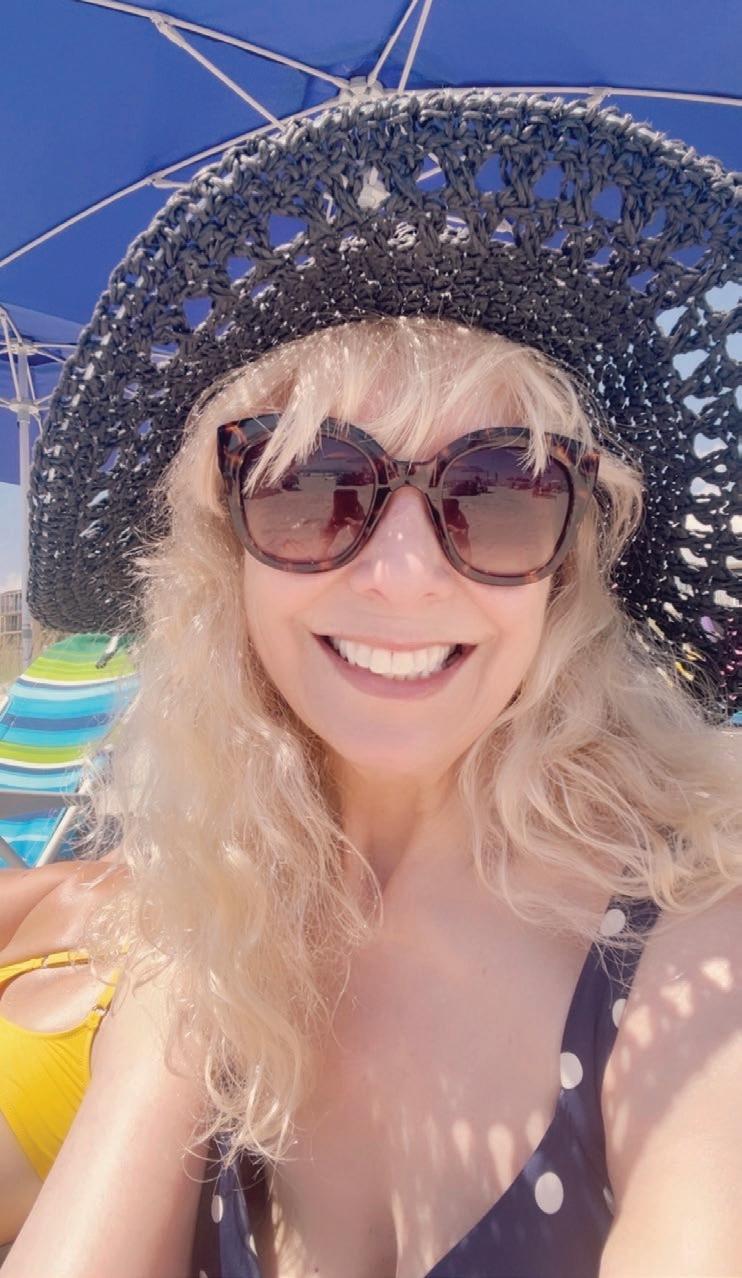
**Real Customer. Verified Results. Thank you gift provided post review. Individual vs Clinical Results may vary.
Visit algaecal.info/robin-success-story or scan the QR code to read her full story.
It’s our most popular option, and here’s why:
It’s the ONLY supplement clinically supported to INCREASE bone density.
It’s guaranteed. If your bone density doesn’t increase in 6 months, you get every cent back.
No gimmicks, no fine print. Just stronger bones or your money back. Scan the QR code below to learn more, or visit algaecal.info/bonebuilderpack
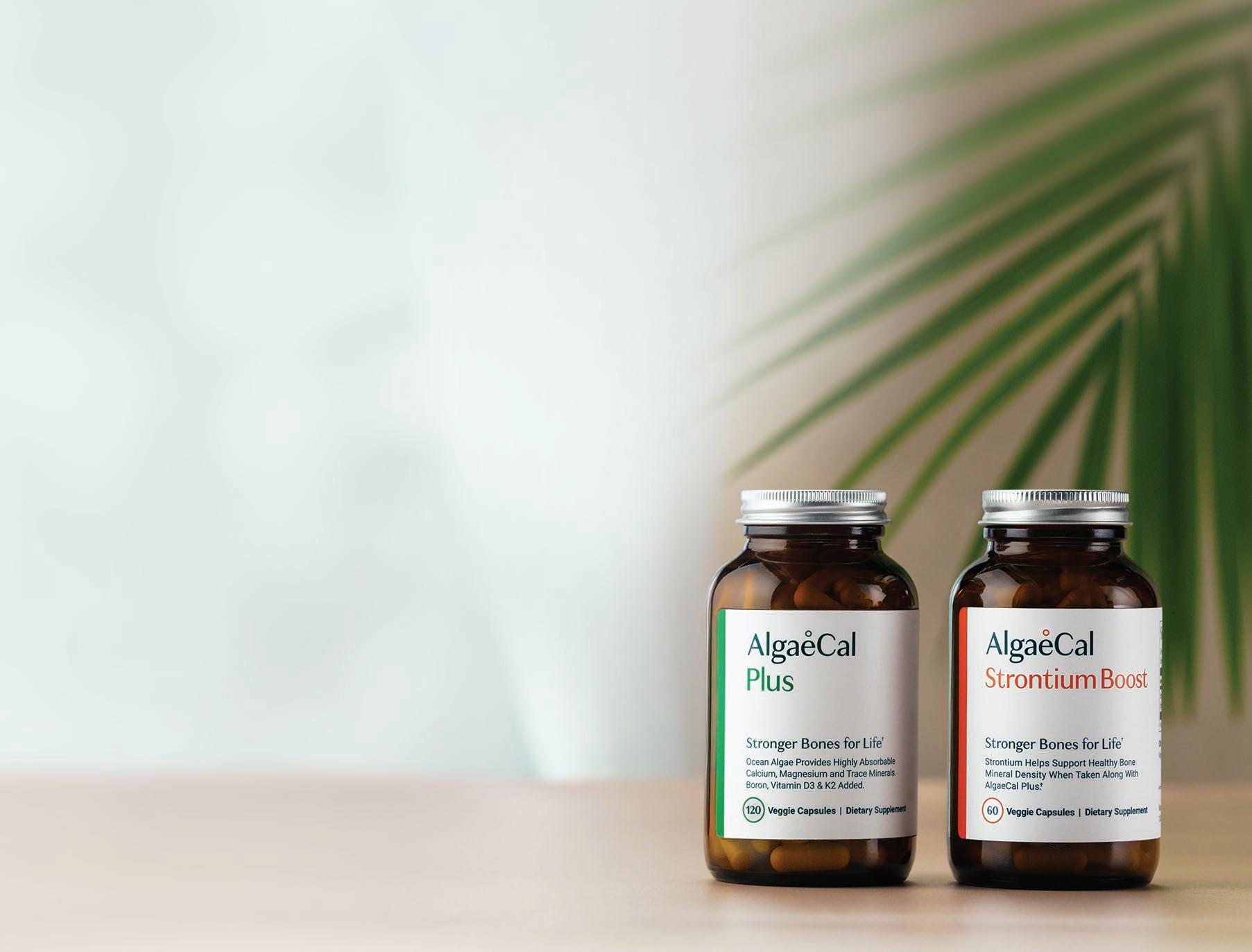

AlgaeCal’s Bone Health Consultants provide exceptional support over the phone, offering personalized guidance to help you navigate your bone health journey. Whether you have questions about bone health, the benefits of AlgaeCal’s products, or how to incorporate them into your daily routine, our team will take the time to listen to your specific needs and provide tailored recommendations.
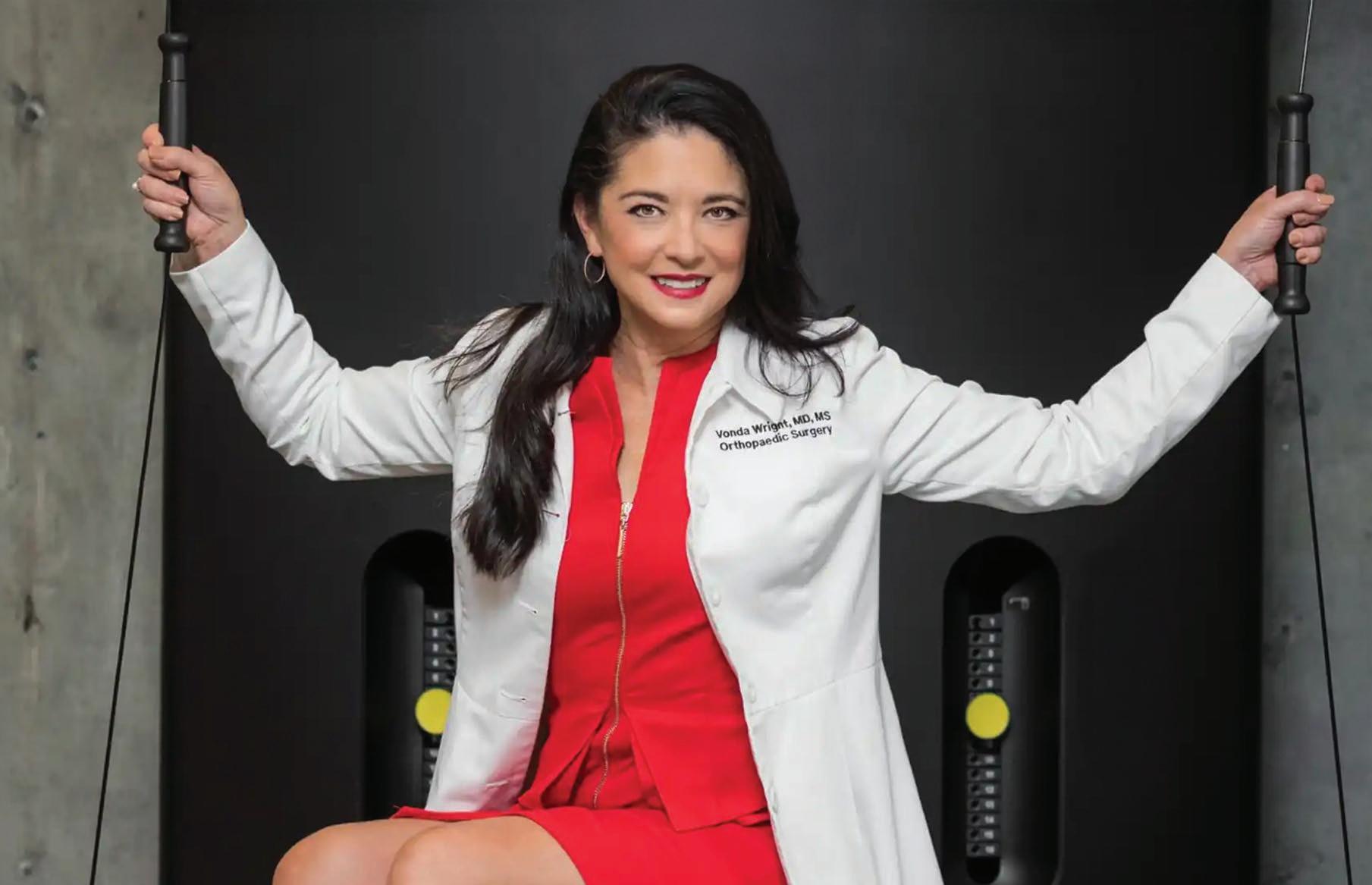
An orthopedic surgeon’s radical prescription for stronger bones, better aging, and the one test she believes every woman needs to get right away!

Interviewed By: Monica Straith BS, BA
Moni is AlgaeCal’s Senior Partnerships Leader, a former Team Canada soccer star, and a busy mom of two active boys.
At 40, Dr. Vonda Wright was in the best shape of her life. But a few years later, everything changed.
“Night sweats, brain fog, total body pain, heart palpitations, everything was falling apart,” she says. “And at the time, I didn’t know because menopause education wasn’t great.”
For millions of women, this story feels all too familiar. You hit your mid-40s or 50s and suddenly the body you knew feels like a stranger. But what makes Dr. Wright different is what she did next. She didn’t just treat the symptoms. She studied them. She listened. And she began to notice a pattern, especially in her female patients.
“They would say, ‘You know what, doc? I don’t know what’s happening to me. I think I’m falling apart.’ And they would say, ‘I asked my doctor and he just said nothing was wrong with me. I think I must be going crazy.’ And then they’d say, ‘I didn’t want to come in today because I have such a high pain tolerance...but I just couldn’t do it anymore.’”
For Dr. Wright, that was the moment something clicked. As an orthopedic surgeon and muscle scientist, she’d spent decades helping people recover from injury. But what she was seeing now was different. Women weren’t just in pain—they were unravelling. And no one had given their symptoms a name. So she did. She called it the Musculoskeletal Syndrome of Menopause.
And from that diagnosis came a new mission: not just to help women survive aging, but to thrive in it. Because as Dr. Wright puts it:
“We don’t have to slow down until much later in life.
We can retain our brains. We can retain our muscle. We can retain our bones.”
And the key? It starts with how you move, how you nourish your body, and how you see yourself.
Dr. Wright’s work first made waves back in 2004, when she began studying masters athletes. Those are adults over 50 competing at the highest levels of amateur sport. What she found was simple but revolutionary.
“When we look at population studies, we’re looking at everybody,” she explains. “And what do we know about everybody in the United States? 70% of people don’t do dedicated mobility or exercise any day of the week. The conclusions we draw from population studies are not necessarily the conclusions of what we can be when we invest in our mobility every day.”
So she created PRIMA: the Performance and Research Initiative for Masters Athletes. Over 15 years, her team documented the profound effects of staying active—not just physically, but neurologically.
“If
you take the variable of sedentary living out and purposely move, we do not have to slow down until much later in life.”
The implications were massive: muscle, bone, brain—all of it can be preserved. But it requires a mindset shift. A refusal to accept frailty as the natural outcome of aging.
“To age with power means you get to do what you want to do when you want to do it, at the rate you want to do it. You can still enjoy the company of others. You are not dependent on other people. And you feel mentally and physically strong.”
In other words: aging with power isn’t about defying time. It’s about reclaiming agency. So how do you do that?
CONTINUED ON PAGE 20
For Dr. Wright, the answer comes down to a prescription she calls “FACE”: Flexibility & Mobility, Aerobic exercise, Carry a load, and Equilibrium & Footspeed.
Flexibility and joint motion are crucial to maintaining range and mobility. Aerobic exercise supports cardiovascular health and energy. “Carry a load” refers to strength training—but as she clarifies, “you can carry a load of anything...five-gallon buckets in the garage and it counts.” And Equilibrium? That’s balance and agility—the skills that help you avoid the kinds of falls that can shatter both hips and independence.
But perhaps the most important piece of this framework isn’t physical—it’s mental.
Purposefully exercising doesn’t just improve your physical strength—it restores something even more powerful: a belief in yourself. The feeling that you’re in charge of your own life. That you can rise, carry weight, and meet whatever the day throws your way.
And that’s everything. Because the world doesn’t always celebrate women as they age. But movement does. It tells you the truth—in every muscle, every joint, every step forward: You are not fragile. You are not fading. You are still here. And you are just getting started.
Dr. Wright is a student of resilience psychology, especially the concept of hardiness. “Resilience is the banner of getting back
up when you fall down,” she explains. “But hardiness adds rationality, attitude, and mindset to the resilience picture.”
She describes three key traits: Commitment (believing your life still has purpose), Challenge (being willing to face difficulty head-on), and Control (maintaining a sense of agency) based on the work of Stein & Bartone.
And here’s the twist: physical activity enhances all three.
“Maintaining a physical practice of fitness builds mental resilience. And that’s not just an attitude change—it’s a biochemical change. As we contract our muscles, they transcribe for proteins which go to our brain and build better neurons.”
In other words: movement isn’t just exercise. It’s therapy.
And it’s more powerful than we give it credit for. Exercise doesn’t just tone your body—it rewires your brain. It lifts mood, sharpens focus, and enhances emotional regulation. It creates a physiological foundation for confidence and control—two things many women feel slipping away during midlife transitions.
That’s why Dr. Wright emphasizes building fitness habits, not just chasing motivation. “Willpower fades,” she often says. “Discipline, born from self-worth, is what keeps you consistent.” When you move your body with purpose, you’re not just getting stronger—you’re telling yourself you matter. And that belief changes everything.
Ask Dr. Wright what people get wrong about bones, and she doesn’t hesitate:
“People think that it’s a disease of old ladies,” she says. But that’s wrong. “Bone health is a concern from the minute of our birth and long past our death. Bones are the last living testament of your life. We can dig up your bones and tell you exactly how you lived. They are the record.”
But bones do far more than hold us up. “They’re not just hard columns,” she says.
“Bones are the home of our blood cells. They’re also endocrine organs. They secrete a variety of hormones. They’re master communicators.”
One of those hormones is osteocalcin. It travels throughout the body—supporting testosterone production, improving insulin sensitivity, and even stimulating brainderived neurotrophic factor (BDNF) to help grow new neurons.
And yet, despite their vital role in metabolism, immunity, and hormone regulation, bones often get ignored until it’s too late.
“We may start paying attention when we’re old,” says Dr. Wright, “but bone health is a lifetime pursuit.”
From your growth spurt in adolescence to pregnancy, menopause, and beyond, your bones are always changing. And every stage of life is an opportunity to protect them.
According to Dr. Wright, peak bone mass is reached between ages 25 and 30. But many young women aren’t laying down enough bone during that critical window, often without realizing it.
“If we skip our periods because we’re so athletic for six to nine months, we’re not laying down bone,” she explains. “If we have a chronic disease like asthma and have to be on high-dose steroids, we’re not going to lay down enough bone.”
And that shortfall has long-term consequences. “You can get to your 30s without having laid down enough bone,” she warns.
Then comes pregnancy, when calcium is pulled from a mother’s bones to nourish the baby. “You are making food for your child to the tune of 500 milligrams of calcium a day,” says Dr. Wright. “You must be very, very careful to eat enough to replace those minerals.”
And then comes menopause—or as she calls it, menolescence.
“We start losing bone density to the tune of two to three percent in the five to seven years in the menopause transition. And not even know it.”
That’s why she urges women to get tested sooner. “If you are 65 and get a DEXA scan for the first time and have a T-score equaling osteoporosis...it is a hard and long road back.” Her advice? Don’t wait. “Go get a DEXA scan now or a REMS scan. So you have the longest possible runway to correct it.”
CONTINUED ON PAGE 22
CONTINUED FROM PAGE 21
When it comes to nourishing bones, Dr. Wright’s first rule is simple: eat enough.
“We can’t starve ourselves,” she says. “None of us stay away from frailty by starving ourselves.” Her top priority? Protein. “The bones are 90% collagen. We need the building blocks of bones to build bones.”
She recommends one gram of protein per pound of body weight—a target that’s significantly higher than standard dietary guidelines, but one she believes is essential for building and maintaining strong skeletal tissue.
Next comes calcium, preferably from food sources. Then vitamin D—especially critical for those living in northern latitudes. And rounding out the essentials are key micronutrients: magnesium, zinc, selenium, and boron.
But Dr. Wright is clear: no single nutrient is a silver bullet. “Our body works in a harmonious, almost orchestra or choreography, and you need each of those parts for everybody else to work well.”
Think of it like a symphony. Take away just one instrument, or in this case, one nutrient, and the whole performance suffers.
When asked about Menopause Hormone Therapy (MHT) or Hormone Optimization, Dr. Wright is clear:
“You have the right to choose. However, you must make your choice based on facts and not fear.”
She’s seen the consequences of misinformation firsthand. For years, fear around hormones, especially after the release of the Women’s Health Initiative study, stopped millions of women from accessing safe, effective treatment. But today, Dr. Wright says, we know more. Much more. And when it comes to bones?
“If
for no other reason, take hormones to save your bones.”
Because the numbers don’t lie: “One in two women with osteoporosis will have an osteoporotic fracture in their lifetime. That’s either me or it’s you.”
And if that fracture happens to be your hip? “50% of the time you will not return to the home where you were living before the fracture. And up to 30% of the time, you die.”
It’s stark. But that’s why Dr. Wright is sounding the alarm. She believes women deserve better. Not just better treatments, but better information and the agency to decide what’s right for their bodies. That includes hormone therapy. But it also includes education, exercise, nutrient support, and regular testing.
She doesn’t say every woman must take HRT. But she wants every woman to know what’s at stake, and to make that choice fully informed.
“It’s not about fear. It’s about facts. It’s about protecting your bones, your independence, and your future.”
Because the goal isn’t just to live longer. It’s to live stronger.
There’s one moment in the interview that stands out—not because it’s scientific, but because it’s human.
“I have found that until you believe that you are worth the daily investment in your health...nothing else matters. If you do not believe that you are worth it, you will not invest in yourself.”
This, ultimately, is the heart of Dr. Wright’s philosophy. Aging doesn’t have to mean slowing down. It doesn’t have to mean shrinking, aching, or sitting on the sidelines. It can mean power. Purpose. Resilience. But it starts with a decision. Not a January 1st resolution that fizzles out by February. Not a burst of motivation that fades by the weekend. A real, gut-level
decision that you are worth it. Worth the gym shoes. Worth the scan. Worth the protein shake. Worth the walk, the sleep, the self-respect.
Because as Dr. Wright reminds us, consistency isn’t powered by willpower, it’s powered by belief. And belief is built one small action at a time.
You don’t need to overhaul your life overnight. You just need to show up for yourself, a little more each day. Train like you plan to be here. Nourish like your bones will carry you for decades. Rest like your body deserves recovery.
Because the future you’re building, strong, sharp, mobile, and alive with purpose, starts with the choice to invest in yourself. And that choice? You can make it today.
Want the full story? Scan the QR code to watch Dr. Wright’s powerful interview, raw, real, and packed with insights to change your future.
Read more in Dr. Vonda Wright’s latest book: “Unbreakable: A Woman’s Guide to Aging with Power” at www.theunbreakablebook.com and on IG: @DrVondaWright.
Truth
That No One’s Telling You Visit algaecal.info/dr-vonda-wright-interview or scan the QR code to watch Dr. Wright’s exclusive interview now!
Smoky chorizo, creamy beans, wilted greens, all simmered in a broth that feels like it’s been bubbling on a farmhouse stove all afternoon.
PREP: 15 MIN COOK: 1 HOUR
1 lb cooking chorizo sausage, crumbled
1 tsp smoked paprika
1 small sweet onion, chopped
1 clove garlic, minced
1 Tbsp apple cider vinegar
4 cups of stock, chicken, beef or vegetable
12 baby potatoes, cut in halves
1 can white beans, rinsed
2 cups hearty greens, stemmed and coarsely chopped
3 plum tomatoes, cored and diced
2 oz parmigiano reggiano, freshly grated
Salt and pepper to taste
1. Place the sausage in a medium stock pot over medium-high heat and cook until it begins to render its fat and you begin to see color on the pan. Drain, but do not rinse, the sausage of any excess fat.
2. Reduce heat to medium and add the smoked paprika, onions and garlic. Add apple cider vinegar to deglaze the pan, stirring constantly, and reduce heat to medium.
3. Stir in the stock. Bring to a boil before reducing heat to low. Cover and simmer for 30 minutes.
4. Add the potatoes and white beans. Bring to a simmer and cook on medium heat until potatoes begin to soften, approximately 10 minutes.
5. Add the greens and cook until they begin to wilt and soften, approximately 5 minutes. Stir in the tomatoes and cook, uncovered, for 10 minutes.
6. Garnish with Parmesan and serve immediately.
MAKES 4–6 SERVINGS
per serving Calories: 404 | Fat: 7 g | Protein: 21 g | Sugar: 11 g | Carbs: 65 g | Fiber: 9 g |
Sodium: 653 mg | Cholesterol: 327 mg | Potassium: 1630 mg | Vitamin A: 1869 IU |
Vitamin C: 50 mg | Calcium: 242 mg | Iron: 5 mg |

These peanut butter squares deliver pure bliss in three layers—a fudgy walnut-cocoa crust, silky peanut butter cream, and a dark chocolate finish with a hint of sea salt.
TOTAL TIME: 3 HOURS
Crust Layer:
1 cup dates, pitted
¼ cup date water
3 cups walnuts, chopped
½ cup coconut oil
¼ cup cocoa powder, organic
Peanut Butter Layer:
2 cups peanut butter, smooth, unsweetened
¾ cup coconut oil, melted
½ cup honey, local, liquid or melted
Chocolate Layer:
2 cups dark chocolate chips, 80% cocoa, organic
¼ cup coconut oil
Himalayan pink salt, optional garnish
1. Prepare a 9x13” baking pan by greasing with a minimal amount of coconut oil.
2. In a small pot, add dates and enough water to cover dates. Bring to a boil and remove from heat. Allow dates to soak for 15 minutes.
3. In a food processor or high-speed blender, combine soaked dates and ¼ cup date water. Blend until smooth. Add walnuts, coconut oil and cocoa powder. Pulse until fully incorporated. Press into bottom of the prepared pan.
4. In a medium mixing bowl, combine peanut butter, coconut oil and liquid or melted honey. Whisk until fully incorporated and smooth. Pour over crust and place in freezer for one hour.
5. Once the peanut butter layer is solid, bring a medium pot with 1” of water to a slow simmer. Place chocolate chips and coconut oil for the chocolate layer into a glass bowl. Place bowl over simmering pot of water, creating a double boiler. Melt chocolate and coconut oil together until entirely smooth.
6. Pour chocolate over peanut butter layer, garnish with salt if desired and place in the freezer for one hour until fully solid.
7. Remove pan from the freezer. Using a warm knife, patiently cut into the bars, creating 24 squares. To warm your knife, run under hot water and dry completely. Keep refrigerated for up to one week or freeze for up to one month.
MAKES 24 SERVINGS
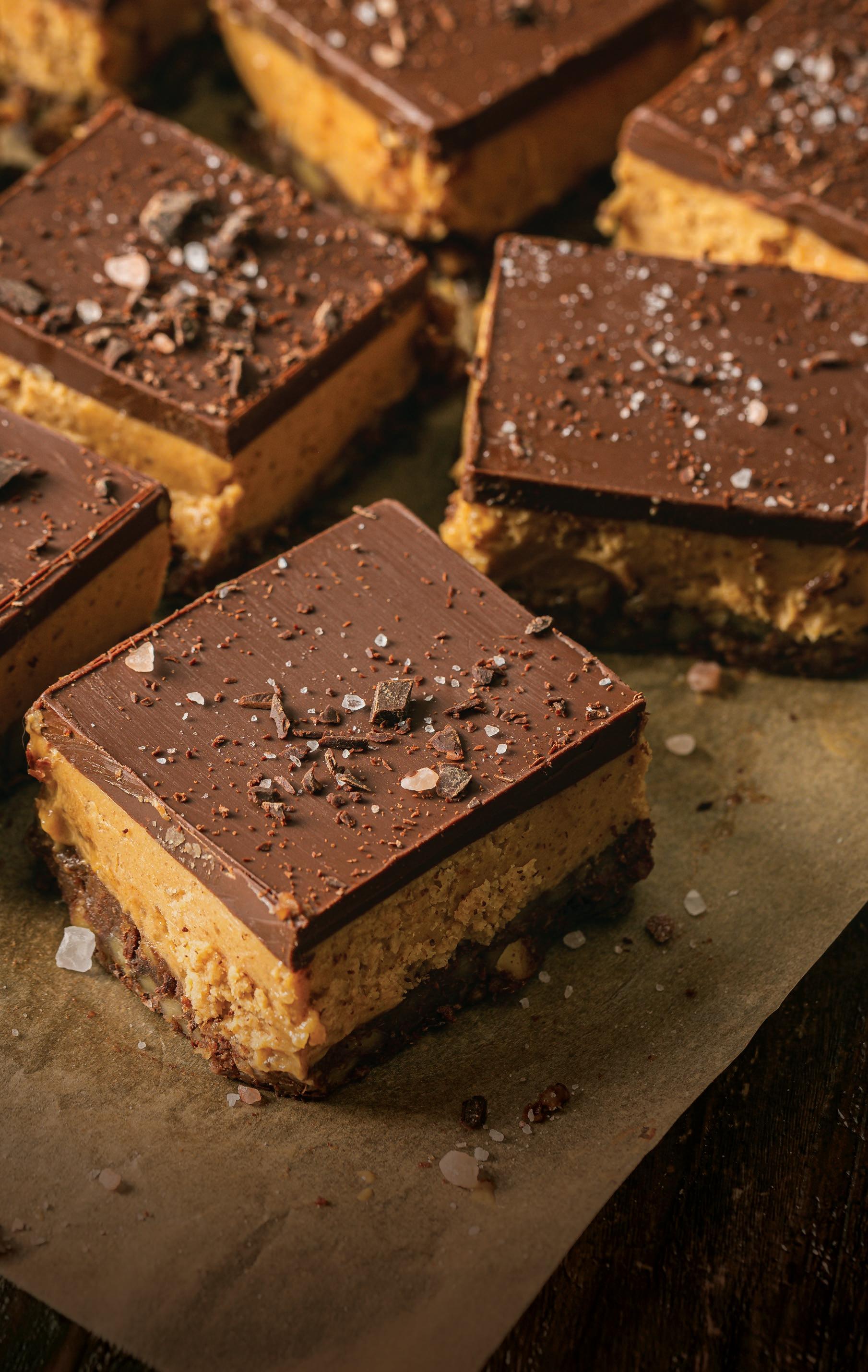
per serving Calories: 459 | Fat: 39 g | Protein: 9 g | Sugar: 17 g | Carbs: 26 g | Fiber: 3 g |
Sodium: 109 mg | Cholesterol: 0.1 mg | Potassium: 338 mg | Vitamin A: 5 IU | Vitamin C: 0.3 mg |
Calcium: 74 mg | Iron: 1 mg |
Have questions about your bone health? Get them answered in The AlgaeCal Community. Our bone health experts are here to support your bone building journey every step of the way.
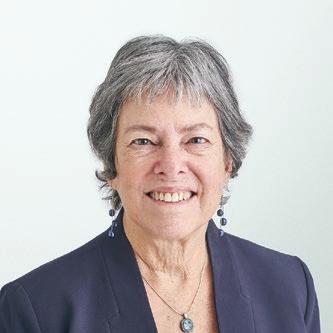
Dr. Liz Lipski
phd, cns, facn, ifmp, bchn, ldn
Professor and Director of Academic Development, Nutrition programs in Clinical Nutrition at Maryland University of Integrative Health. Author of Digestive Wellness
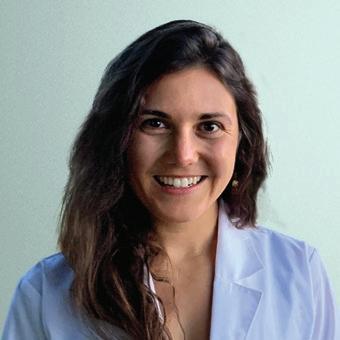
Dr. Emma Gasinski
pt, dpt, ryt
Physical therapist, certified yoga teacher and CrossFit trainer with a Doctorate in Physical Therapy from Rocky Mountain University of Health Professionals.
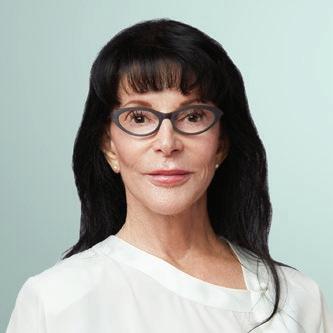
Lara Pizzorno mdiv, ma, lmt
Best-selling author of Health Bones Healthy You! And Your Bones; Editor of Longevity Medicine Review, and Senior Medical Editor for Integrative Medicine Advisors
I take a number of vitamins. Are vitamins considered acidic or alkaline? I have acid reflux and cannot determine if it’s due to diet or vitamins.
Maryann G. Algaecal Community Member
Hi Maryann! Whether a supplement is acidifying or alkalizing depends on its chemical makeup. For example, calcium and magnesium are typically alkalizing, while betaine hydrochloride is acidifying. But for people experiencing reflux, the real issue may not be pH, it’s how certain supplements affect the stomach lining and digestive system. Research and clinical reports have linked several common supplements with reflux symptoms in sensitive individuals. These include iron, effervescent vitamin C, multivitamins, vitamin E, potassium, and some herbal products like valerian, peppermint oil, and oregano oil. Even compounds like apple cider vinegar, hydrochloric acid, and bitters, often used to improve digestion, can either help or worsen reflux depending on individual tolerance. If you suspect your supplements are contributing to discomfort, a brief pause of 7 to 10 days can help. If symptoms improve, reintroduce one at a time to identify any triggers. You might also try taking supplements with food, switching to chewable or powdered forms, or adjusting the timing. Everyone’s response is different, so treating this as a personal experiment is the best way to find what works for your body.
Dr. Liz Lipski
I am 61 years old and 9 years post menopause. Is it too late for me to start taking bioidenticals? I have osteopenia and am having terrible sleep.
Sue B. Algaecal Community Member
Hi Sue! Bio-identical hormone replacement therapy (BHRT) can be safe and effective when properly tested, prescribed, and monitored by a knowledgeable doctor. BHRT requires personalized dosing based on the results of a comprehensive 24-hour urine hormone test and an initial follow up test 6 months after starting to ensure your estrogens are being safely and beneficially metabolized. After that, you should be tested once a year to make sure your hormone metabolism and prescription remain optimal for you.
Lara Pizzorno
A:Could walking briskly on an uneven road cause pain in the back, hips, or joints? I recently started walking on a path that’s not completely flat—it’s a bit uneven, though not too bumpy. Since then, I’ve been feeling pain in my back and hips. Should I avoid this kind of surface? Thanks in advance!
Nahid B. Algaecal Community Member
Hi Nahid! Walking on uneven ground isn’t harmful, but it can place new stress on your hips and back, especially if your body isn’t ready for a new asymmetrical load (most aren’t!). Try short 5-10 minute walks to let your body adapt gradually. Over time, this can improve stability, strength, and load tolerance.
Dr. Emma Gasinski
Reach out to our experts today in the AlgaeCal Community!
The AlgaeCal Community is an exclusive Facebook group for AlgaeCal customers. It’s made up of over 43,000 women and men who are working toward renewed bone health. It’s a friendly, supportive space where you can ask questions, join live exercise classes and bone-health lectures, share frustration and successes, and make new friends. Join for free by scanning the QR code below.
Here’s what you get…
• Direct Access to Doctors, Physiotherapists, & Bone Health Experts
Get answers to your toughest questions, fast.
• Physio-Led Exercise Classes
Strengthen your bones safely with exercises designed by leading fitness experts.
• Join a Group of 43,000+
Share wins, get support, and feel the encouragement of others on the same journey.
• Exclusive Monthly Product Giveaways Yes, you could win free products every month. ...and much more!
Mark your calendar! Some exciting Community events are just around the corner. Up Next:
Get Fit With Sandra | Join Sandra’s weekly foundation classes to build strength, stability, and confidence from the ground up.
Community Anniversary Giveaway | To celebrate another year of this amazing community, we’re giving away exclusive prizes all month long. Stay tuned.
Interview with Dr. Wendie Trubow | Dr. Trubow shares what every health-conscious person needs to know about hidden toxins and their effects on bone health.